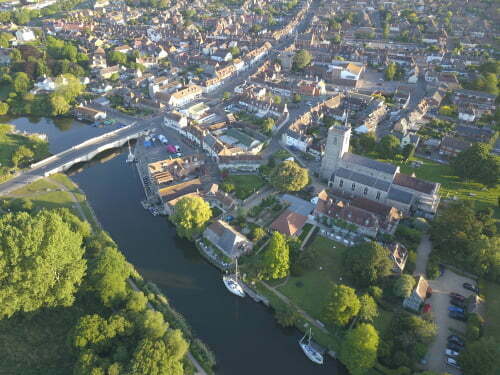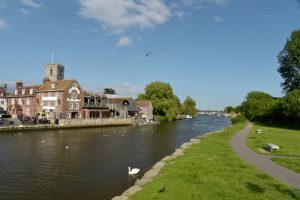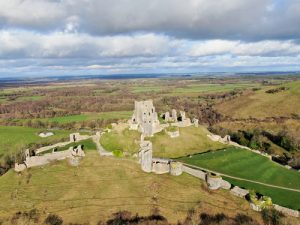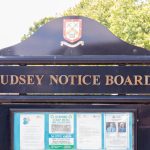
Wareham in Brief
Wareham is a historic market town and civil parish in Dorset, southwest England. The town is situated about 8 miles (13 km) southwest of Poole and 15 miles (24 km) east of Dorchester. It also lies between the River Frome and River Piddle at the head of the Wareham Channel. A little idiosyncratically, Wareham is often referred to as ‘Wareham Town’. The town is arguably best known for its historic link with ‘Lawrence of Arabia’. In 2019, the estimated population of Wareham was 6,029.

Wareham is idyllically situated on the River Frome. Image credit: David Young/Shutterstock.com
A Fleeting History
Early Days
There is archaeological evidence to suggest that the Wareham area has been continuously occupied for some 9,000 years. The Romans also built a small settlement in the area. When the Romans departed at the start of the 5th century, the Celts took over the local occupation. However, it was the invading 7th-century Saxons who founded the modern-day settlement of Wareham. In the late 7th century, the Saxon abbot St Aldhelm founded a monastery at Wareham. The settlement that grew up around the monastery became known as “wer ham”, i.e. ‘village by the weir’.
In 876, Wareham was captured by the Danes. The King of Wessex, Alfred the Great, arrived at the town with an army. However, he was forced to make a treaty with the superior Viking forces. After the Danes departed, Alfred made Wareham one of his ‘burhs’. These were a network of fortified settlements built across the Kingdom of Wessex.
From the late 9th century, Wareham was fortified by the completion of earth walls on three sides. The Southern side was protected by the River Froome and the surrounding marshlands. However, in 1015, the famed Viking King Canute made a successful raid on the town, which left it in ruins. Nonetheless, the town made a rapid recovery and soon went on to thrive once again.
Norman Times
By the time of the Norman Conquest of 1066, Wareham was one of the important towns in Dorset. A measure of this was the fact that it was home to two royal mints. In 1068, William I and his army passed through Wareham on their way to lay siege to Exeter. The area was one of the last strongholds of Saxon resistance. It was soon after that the Normans built a castle on the banks of the River Frome at Wareham.
The castle featured heavily in the fighting between the forces of Stephen and Matilda during the mid-12th century civil war. In 1154, the castle passed to the Earl of Gloucester, only to be confiscated by the Crown in 1199. The castle was returned to the Earl in 1216 but abandoned soon afterwards in favour of Corfe Castle in southeast Dorset.
The 13th century saw Wareham develop to become one of England’s most crucial south coast ports. Subsequently, in 1248, Wareham was granted a town charter. However, the growth of Poole and the gradual silting of the River Frome caused a decline in Wareham’s maritime trade. By the end of the century, most of Wareham’s port trade had transferred to Poole.
Dissolution and Civil War
Henry VIII’s dissolution of the monasteries saw Wareham Priory dissolved in 1539. Henry granted the Manor and Borough of Wareham to several of his wives. They remained in the hands of the Crown throughout the reign of Elizabeth I. However in 1572, Wareham Castle, together with the Isle of Purbeck and the Manor of Corfe, was granted by the Queen to her Lord Chancellor, Sir Christopher Hatten. He sold off most of the castle’s stone, which was used to construct other local buildings. During the early 17th century, the manor of Wareham was purchased from the Crown by a small group of wealthy townsfolk.
During the English Civil War, the possession of Wareham changed hands several times between Royalist and Parliamentary forces. In August 1644, Wareham was the site of a huge battle that saw some 2,000 of Cromwell’s army besiege the town. Following the Monmouth Rebellion in 1685, Wareham was one of several Dorset towns where Judge Jeffreys presided over the ‘Bloody Assizes’. The sentences metered out saw five local rebels hanged, drawn, and quartered at West Walls. This saw the area being christened the ‘Bloody Bank’.
Disaster and Re-build
By the middle of the 18th century, Wareham’s traders were benefitting from contracts to supply fresh produce and other commodities to the Royal Navy at Portsmouth. Another important industry to the town at this time was mining for the rare and valuable ball clay. The clay was highly prized for its whiteness and use in the pottery industry. However, a disaster also struck the town in the mid-18th century. On Sunday 25 July 1762, a fire started on a rubbish tip on South Street. The fire razed around 140 buildings to the ground, some two-thirds of the town. It was reported that no one was killed in the fire.
After the fire, an act of Parliament was sought and passed to rebuild Wareham. A country-wide appeal fundraised around £7,500. King George III himself contributed £500 to the coffers. The local mayor imposed strict rules for the rebuilding of the town. Timber buildings and thatched roofs were prohibited and streets were widened to provide a fire break. New houses were built in the typical Georgian style of the period, a characteristic that the town has managed to retain.
The 19th Century
The advent of the industrial revolution towards the end of the 18th century saw Wareham once again in decline. The local cottage and craft industries prevalent throughout Dorset were hit hard by the new technology. Wareham’s home-based button makers were particularly affected. By the early 1800s, unemployment throughout Dorset’s rural population was high. Additionally, the county’s farm labourers were some of the poorest paid in the country. Lack of work and poor pay saw many Dorset families emigrate to America and Australia in search of a better life.
In 1840, local philanthropist, Lady Burdett Coutts, established a brickworks at Sandford. Her main ambition was to create jobs and alleviate local poverty. In 1847, the town saw both gas-lit streets and the railway arrive. In 1885, a branch line to Swanage was established. A new train station was built to replace the original terminal in 1887. During the 19th century, brewing was also an important industry in Wareham. Bennett’s and Panton & Co. were the town’s main brewers, though the latter was in decline by the end of the century.
The War Years
During the Great War (1914-18) some 7,000 servicemen were stationed at Wareham, one of Dorset’s largest military camps. In 1915, an ammunitions factory was built a few miles from Wareham at Holden Heath. The factory remained open until the 1930s when it was duly closed following an explosion that killed 10 workers.
During WW2, the Holden Heath ammunition factory was reopened to assist the war effort. At Worth Matravers, a few miles from Wareham, a top-secret research centre was established for the development of long range radar. Thought to have been the action of a ‘lost’ German bomber, a lone bomb struck Wareham in December 1942. The blast destroyed several properties and some people sustained injury but there were no fatalities. In 1943, the nearby coastal village of Tyneham was evacuated so it could be used for military training purposes.
The Modern Era
Immediately after the war, Wareham’s population was still less than 2000. However, the UK’s post-war housing boom of the early 1950s saw the town’s population grow steadily, such that within 20 years it had reached around 4,500. Conversely, from the 1950s, the town’s traditional industries, such as pottery, had either declined or disappeared altogether. In 1972, Wareham’s branch line to Swanage was closed. The town’s road by-pass was completed in the early 1980s.
Today, Wareham town centre has retained many of its Georgian buildings giving the town an olde-worlde atmosphere. The local economy is largely based on the service sector, although it does have two small industrial estates. Major local events include the town’s annual carnival which takes place in July and includes a parade, fireworks, and music. Another annual event is the Wareham Music Festival, which is also held during the summer season. Some of the venues you’ll find bands playing are the Quay, the Town Hall, and the town’s pubs. Weekly events include local markets, which are held on Thursdays and Saturdays.
Wareham is twinned with Conches-en-Ouche in France, and Hemsbach in Germany.
Getting to Wareham
Wareham is situated on the A351 which runs northwards from Corfe Castle to Lytchett Minster. The most direct route to Wareham from London and the Southeast is M3/M27/A31/A3049/A35/A351. From the Midlands and the North, the easiest road route is the M4/A350/A35/A351.
South West trains operate an hourly service from London Waterloo to Weymouth that passes through Wareham. The rail journey from London to Wareham takes around 2 hours 15 mins.
The nearest airports to Wareham are Bournemouth (BOH) 17 miles away, and Bristol (BRS) 82 miles away.
Notable Residents
- Colonel T.E. Lawrence (1888 – 1935) – universally better known as ‘Lawrence of Arabia’, was a part-time resident at his holiday cottage ‘Clouds Hill’, near Wareham, between 1923 and 1935.
- Renowned British actor Edward Fox has held a part-time residence at Wareham for many years. Born in 1937, Fox began his film acting career in 1962 and is still active to date (2021).
- Notorious politician David Mellor was born in Wareham on 12 March 1949. He was also educated at Swanage Grammar School. The former barrister served as a member of Margaret Thatcher’s Tory Cabinet between 1987 and 1992.
Did You Know?
The famed author TE Lawrence (Lawrence of Arabia) was fatally injured in a motorcycle accident close to his ‘Clouds Hill’ cottage, near Wareham, on 13 May 1935. Lawrence was riding his beloved Brough Superior SS100 motorcycle when a dip in the road obscured his view of two boys on bicycles. He swerved to avoid them, lost control of his motorbike, was thrown over the handlebars, and ended up seriously injured. He died in hospital six days later on 19 May 1935, aged 46. The accident occurred just two months after he’d ended his military service. The site of the crash is still marked by a small roadside memorial.
Sport in Wareham
Wareham Rangers FC
Wareham Rangers FC currently (2021) plays in the Dorset Premier League. They play home games at the Purbeck Sports Centre on Worgret Road.
Swanage & Wareham RFC
Swanage & Wareham RFC is a rugby union team that’s based in Wareham. They currently (2021) play in the Southern Counties South League of the South West Division.
Things to see and do in Wareham
Wareham’s Museums
Wareham Town Museum tells the story of the Wareham area from prehistoric times to the present day. There’s a special section dedicated to the memory of Lawrence of Arabia. The museum’s displays are regularly updated with new exhibits. The museum is open Mon to Sat, 10 am – 4 pm.
Wareham’s Tank Museum has over 300 exhibits which are reputed to be the world’s biggest such collection. As well as tanks, there are trails, quizzes, interactive games, talks, and tours. Additionally, there are indoor/outdoor play areas for children, as well as an on-site restaurant and café.
Wareham Boat Hire
Wareham Boat Hire offers you the opportunity to rent a motorboat, canoe, kayak, rowing boat, or paddleboard by the hour or day. They also offer river cruises and boat trips.
Clouds Hill
The isolated ‘Clouds Hill’ cottage, about 7 miles from Wareham, was once the private retreat of T. E. Lawrence (Lawrence of Arabia). Today, managed by the National Trust, it’s pretty much as Lawrence left it in 1935.
Corfe Castle
The 1000-year-old ruined castle is perched on a hilltop that overlooks the village of the same name. The castle is one of the most popular tourist attractions in Dorset. Destroyed during the English Civil War in 1646 it lies just 4 miles southeast of Wareham.

An aerial view of Corfe Castle. Image credit: Dorset Drone Photography/Shutterstock.com
Corfe Castle Model Village
The model village is a 1/20th scale model of the castle and village as they were in 1646. The castle has been replicated to the way it was just before Crowell had it destroyed. The one-acre site also displays related historical artefacts such as stocks and pillories. There’s also a tearoom and gift shop on site.
Tyneham ”Ghost” Village
Tyneham village lies 7 miles south of Wareham. The area was purchased by the government during WW2, for training purposes. The villagers were promised they could return after the war but they never did. The ghost village, still owned by the military, has seen some buildings fully restored to the way they were in the 1940s. The popular attraction is open to the public at weekends.
Monkey World
Monkey World is a primate and ape rescue centre and one of Dorset’s top attractions. It lies just down the road from Wareham, at Bovington. The centre rescues chimps, monkeys, and apes from the likes of the illegal pet trade and entertainment industries. They are rehabilitated and put into the wild whenever it proves possible.
Where to stay?
Wareham and the immediate surrounding area offer a decent range of accommodation choices. However, it’s mainly self-catering and holiday-let style accommodation. However, it’s also possible to find luxury hotels, B&Bs, and inns. Nearby Corfe Castle offers more accommodation options, and further afield (9 miles), Poole.
Moving to Wareham?
Properties in Wareham sold for an average price of approximately £419,000 over the last year (Oct 2021). The best-selling houses were detached properties, which sold for an average price of around £576,000. Flats sold for an average price of £218,000 terraced properties for £337,000, and semi-detached properties fetched £307,000. Overall, the average sold property price in Wareham over the last year was 19% up on the previous year.
Thinking of a Staycation?
Are you thinking of holidaying in the UK sometime soon? If so, why not check out some of our other travel guides for some staycation ideas? I think you’ll be surprised at the variety of great things to do in the UK’s fairly green and mostly pleasant land.
Header image credit: On The Wing UAV Ltd/Shutterstock.com
Why Not Take the Wareham Quiz?
Quiz Maker – powered by Riddle


